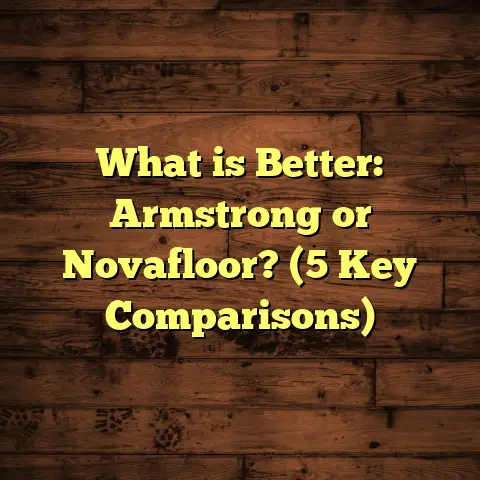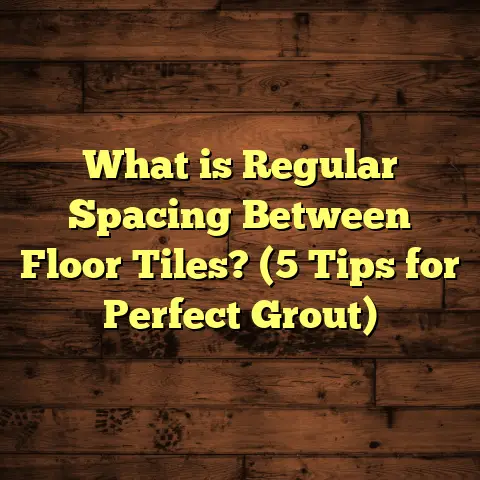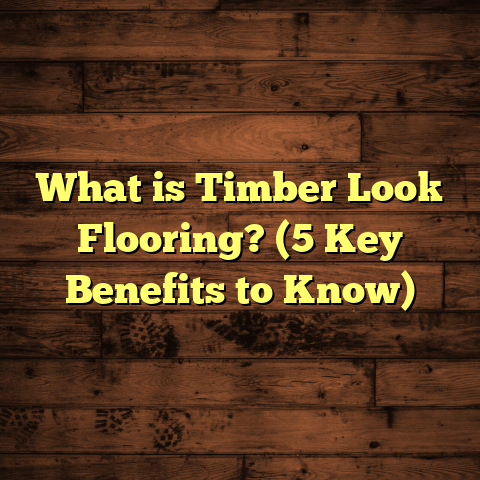What Is Bamboo Flooring Made Of? (5 Facts You Must Know)
Customizability and Bamboo Flooring: Why It Matters
I’ve always found one of the most exciting things about bamboo flooring is how customizable it truly is. When I start talking with clients about flooring options, one question that pops up often is, “Can I get bamboo in different colors or finishes?” The answer is yes, and that’s what makes bamboo so appealing.
You can go from a sleek, pale finish that brightens up a room to a deep, rich tone that adds warmth and character. This flexibility means bamboo flooring can fit just about any interior style—from ultra-modern lofts to cozy, rustic homes. It’s like having a blank canvas you can color however you want.
I remember a client who wanted a Scandinavian vibe with light floors but also something sustainable. We chose a natural bamboo finish with a matte coating that preserved the light tone but gave it a soft texture underfoot. The result was stunning and exactly what she envisioned.
Customizability goes beyond color. Bamboo planks come in different widths, locking systems, and even textures. Some have smooth surfaces; others are hand-scraped or wire-brushed for added character. This variety opens doors for creative design without compromising on durability or eco-friendliness.
But before we get too far into styling, let’s start with the basics: What exactly is bamboo flooring? What is it made of?
What Is Bamboo Flooring Made Of?
Bamboo flooring is crafted from the bamboo plant—a fast-growing grass species native to Asia but now grown all over the world. Unlike hardwood floors, which come from trees that take decades to mature, bamboo grows quickly—sometimes up to 3 feet in a single day! This rapid growth is why bamboo is often touted as a renewable, sustainable material.
But here’s the thing: bamboo floors aren’t just raw bamboo stalks nailed down on your floor. They undergo several manufacturing steps to become the durable, attractive planks you see in homes and businesses.
The Manufacturing Journey: From Plant to Plank
The journey starts by harvesting mature bamboo stalks—usually at 5-7 years old when they’ve reached optimal hardness. Then comes boiling, which removes sugars and starches that could attract pests or cause mold issues later. After drying to reduce moisture content, the stalks are sliced or shredded depending on the type of flooring being made.
Next up is pressing and gluing:
- Horizontal Bamboo Flooring: Strips are glued together side-by-side horizontally.
- Vertical Bamboo Flooring: Strips are glued vertically.
- Strand Woven Bamboo: Fibers are crushed and woven under extreme pressure before gluing.
Finally, the planks are sanded smooth and coated with finishes like polyurethane or natural oils for protection and shine.
This process transforms raw bamboo from a simple grass into tough, stylish flooring ready for your home.
How Bamboo Differs from Hardwood
You might wonder: “Is bamboo actually wood?” Technically, no—it’s a grass. But after processing, it behaves much like hardwood in terms of durability and appearance.
Since it’s grass, bamboo grows faster and regenerates without needing to be replanted. This means less environmental impact compared to slow-growing hardwood trees like oak or maple.
In my experience working with both hardwood and bamboo floors, I’ve noticed bamboo often resists scratches and dents better than some hardwoods because of its density—especially strand woven varieties.
Fact 1: Bamboo Flooring Is Made Primarily From Bamboo Grass
Let’s look closer at the plant itself. Bamboo belongs to the grass family Poaceae, which also includes wheat, corn, and sugarcane. Unlike trees that grow rings over decades, bamboo grows in tall cylindrical stalks called culms.
The species most commonly used for flooring is Moso bamboo (Phyllostachys edulis), native to China. Moso’s stalks can reach heights of over 50 feet and diameters of 4 inches or more—ideal for manufacturing durable planks.
Because bamboo is grass, it has unique cellular structures compared to wood. Its fibers run longitudinally along the stalk, giving tensile strength similar to steel in some cases.
Why Does This Matter?
This composition explains why bamboo flooring can be incredibly strong but also flexible enough to withstand impacts without cracking easily.
I once used strand woven bamboo on a gym floor installation where heavy weights were dropped regularly. The client was amazed at how little damage occurred over months of use.
Growth Rate: A Sustainability Highlight
Bamboo’s rapid growth is one of its strongest selling points environmentally. While oak takes 20-50 years to mature, Moso bamboo matures in just 5-7 years. That means plantations can harvest more frequently without deforestation.
According to research from the World Bamboo Organization:
“Bamboo produces 35% more oxygen than equivalent stands of trees and absorbs carbon dioxide at a higher rate.”
This makes bamboo not just a flooring material but also a small carbon sink helping reduce greenhouse gases.
Fact 2: The Manufacturing Process Shapes Durability and Appearance
Not all bamboo floors are created equal—how they are made changes everything from hardness to how they look.
Let me walk you through the three main types of bamboo flooring and what sets them apart:
Horizontal Bamboo Flooring
This method involves slicing the stalks crosswise into horizontal strips and then laminating these strips side-by-side. The result shows visible nodes—the characteristic rings along the stalk—which give it a unique striped pattern.
It’s aesthetically distinctive but tends to be softer than other types because the grain runs horizontally across the plank surface rather than vertically along fibers.
Vertical Bamboo Flooring
Here, long strips are glued standing upright side-by-side, so the grain runs vertically along the length of the plank. This creates a tighter grain pattern with fewer visible nodes and is generally harder than horizontal bamboo due to fiber orientation.
Many homeowners prefer vertical bamboo for its uniform look that resembles traditional hardwood floors.
Strand Woven Bamboo Flooring
This type is made by crushing bamboo fibers into strands and weaving them randomly before compressing under intense heat and pressure with high-quality adhesives.
The result? A floor that is denser and harder than most hardwoods—up to three times harder than oak according to Janka hardness tests.
I installed strand woven floors in a busy retail space where durability was critical. Even under constant foot traffic and moving furniture, the floor resisted dents and scratches exceptionally well.
Why Does Manufacturing Matter?
If you’re investing in flooring, you want it to last—and look good doing it. Knowing these differences helps pick the right product for your lifestyle.
For example:
- Horizontal bamboo might be great for low-traffic residential spaces or accent areas.
- Vertical bamboo works well in mid-traffic zones like living rooms or bedrooms.
- Strand woven is ideal for high-traffic commercial or active family homes.
Fact 3: Adhesives & Finishes Used Can Impact Health & Longevity
Ever wonder what holds those bamboo strips or fibers together? That’s where adhesives come in—and they matter for both durability and indoor air quality.
Adhesives: Formaldehyde & Alternatives
Most bamboo floors use adhesives containing formaldehyde resins (urea-formaldehyde or phenol-formaldehyde) because these create strong bonds essential for floor stability.
However, formaldehyde has been linked to indoor air pollution concerns. Thankfully, many manufacturers now offer low-formaldehyde or no-added formaldehyde options certified by programs like CARB (California Air Resources Board) Phase 2 standards or GREENGUARD certification.
When installing floors in homes with children or allergy sufferers, I always recommend checking for these certifications to ensure healthier indoor air quality.
Finishes: Protecting Your Investment
Finishes add a protective layer on top of bamboo planks that help resist moisture, scratches, and wear.
Common finishes include:
- Water-based Polyurethane: Dries fast, low odor; great for indoor air quality.
- Oil-based Polyurethane: Durable but stronger fumes during installation.
- Aluminum Oxide Coatings: Found in prefinished floors; extremely scratch-resistant.
- Natural Oils & Waxes: Eco-friendly options providing matte finishes but require more maintenance.
For a recent kitchen renovation where heavy cooking spills were expected, we went with aluminum oxide prefinished strand woven bamboo because it could withstand moisture better than natural oils alone.
Fact 4: Bamboo Flooring Can Be Solid or Engineered
You may have seen solid wood versus engineered hardwood—bamboo has similar options:
- Solid Bamboo Flooring: Made entirely from compressed bamboo strips glued together.
- Engineered Bamboo Flooring: A thin layer of bamboo veneer adhered over plywood or fiberboard backing.
Engineered bamboo provides better dimensional stability because its plywood base reduces expansion and contraction caused by humidity changes.
In humid climates or rooms like basements where moisture fluctuates more often, engineered bamboo helps prevent issues like warping or cupping.
In one coastal home I worked on recently, we chose engineered strand woven bamboo. Despite seasonal humidity swings above 70%, the floor maintained a smooth surface with minimal gaps after two years—something solid wood wouldn’t have managed as well.
Fact 5: Different Bamboo Species Affect Flooring Quality
While Moso bamboo dominates the market due to its size and fiber strength, other species also influence characteristics:
- Guadua Bamboo: Native to South America; known for exceptional toughness but less common internationally.
- Tonkin Cane: Used mainly for decorative purposes due to smaller diameter stalks.
- Other lesser-known species are used regionally but not widespread commercially.
Understanding species helps select flooring suited for specific needs—whether maximum hardness or aesthetic preference.
My Personal Experiences With Bamboo Flooring Projects
Over my years as a flooring contractor, I’ve installed all types of flooring materials—from traditional oak and maple hardwoods to exotic tropical woods and laminates. Bamboo stands out for several reasons:
Project One: Family-Friendly Living Room
A young family with two dogs wanted resilient floors that didn’t show scratches easily yet felt warm underfoot. We went with strand woven bamboo stained medium brown with an aluminum oxide finish.
After 3 years of pets running around and kids playing hard on the floor? It still looks fantastic with barely any visible wear spots. The family told me they love how easy it is to clean compared to carpet or softer woods they had before.
Project Two: Urban Loft Renovation
In a downtown loft with industrial decor, clients wanted light-colored floors to brighten up open concrete walls but also maintain durability. Vertical bamboo with a whitewashed finish fit perfectly.
We used water-based polyurethane for minimal fumes during installation since the clients were moving in right away. The floors gave a modern yet natural feel that balanced their aesthetic beautifully.
Project Three: Commercial Boutique Store
One challenge was installing floors in a retail space with heavy foot traffic daily. We chose strand woven bamboo with an aluminum oxide topcoat—this combo held up against shoes dragging merchandise carts without scratching easily over two years of operation.
Detailed Data Points & Research Insights
Bamboo isn’t just hype; there’s solid science backing its advantages:
- According to Janka Hardness Scale tests:
- Strand woven bamboo scores around 3000+ lbf, significantly harder than:
- White oak (1290 lbf)
- Hard maple (1450 lbf)
- Strand woven bamboo scores around 3000+ lbf, significantly harder than:
- Carbon footprint studies show that harvesting bamboo results in approximately 6 kg CO₂ per m², roughly half that of traditional hardwoods (12 kg CO₂ per m²).
- Life cycle assessments indicate:
- Bamboo plantations regenerate faster.
- Less energy input required due to shorter harvesting cycles.
These numbers mean bamboo flooring offers both performance and environmental benefits compared to many conventional options.
Handling Common Issues With Bamboo Flooring
Even though I’m a big fan of bamboo floors, I want you to know about some usual concerns so you can avoid surprises:
Moisture Sensitivity
Bamboo can absorb moisture if not sealed properly—leading to swelling or warping like any natural material. Engineered products handle this better but still need care around wet areas.
In bathrooms or kitchens, I suggest using water-resistant finishes or adding rugs near water sources.
Scratches & Dents
Despite its hardness, improper use can cause damage—especially from sharp heels or heavy furniture legs without pads. Strand woven types resist this best but no floor is completely indestructible.
Routine cleaning with soft tools and felt pads under furniture helps extend life significantly.
Color Fading
Some bamboo finishes may fade if exposed to direct sunlight long-term. Using window treatments or UV-protective coatings helps maintain appearance longer.
Step-By-Step Installation Basics From My Experience
If you’re thinking about installing bamboo yourself or want to understand what pros do on-site, here’s an overview:
- Acclimate Your Flooring: Let planks sit in the room for at least 72 hours so they adjust to temperature and humidity.
- Prepare Subfloor: Ensure it’s clean, dry, flat (within 3/16 inch over 10 feet), and structurally sound.
- Install Underlayment: Helps with moisture barrier and sound absorption.
- Lay Out Planks: Start from one corner using spacers for expansion gaps.
- Use Proper Tools & Adhesives: Follow manufacturer instructions if glue-down; floating floors use click-lock mechanisms.
- Cut Carefully: Measure twice before cutting planks with appropriate saws.
- Finish Edges & Trim: Add baseboards or quarter rounds to cover expansion gaps.
- Maintain Cleanliness During Installation: Avoid dust buildup which can affect adhesion or finish quality.
- Post-installation Cleaning: Use recommended cleaners; avoid harsh chemicals initially as finishes cure fully over days/weeks.
With proper care during installation, your bamboo floors will look great and last decades.
Caring For Your Bamboo Floors: Tips I Swear By
Maintaining your investment is key:
- Sweep/vacuum regularly with soft brush tools.
- Wipe spills immediately—especially liquids like wine or juice.
- Use damp mops with gentle cleaners specifically designed for wood/bamboo floors.
- Avoid steam cleaners—they introduce too much moisture.
- Place mats at entrances to reduce dirt tracked inside.
- Rotate rugs periodically to prevent uneven fading.
- Use furniture pads under legs.
Clients often tell me their bamboo floors stay beautiful longer than expected by following these simple steps.
Final Thoughts: Why Knowing What Bamboo Flooring Is Made Of Matters
Understanding what goes into making your floors helps you make smarter decisions—not just based on looks but durability, environmental impact, health safety, and maintenance needs.
Bamboo flooring combines natural beauty with technical innovation—from growing fast grass stalks through advanced manufacturing processes like strand weaving—to creating versatile products suited for various lifestyles.
Whether you’re renovating your home or outfitting commercial space, knowing these five facts gives you confidence when choosing this material:
- It comes from fast-growing bamboo grass.
- Manufacturing methods impact strength & style.
- Adhesives & finishes affect durability & indoor air quality.
- Options exist between solid and engineered formats.
- Species type influences quality characteristics.
If you want floors that can adapt in style and stand up over time while reducing environmental footprint—bamboo is definitely worth exploring further!
Feel free to reach out anytime if you want advice tailored specifically for your project—I love sharing what I’ve learned firsthand working alongside homeowners and businesses alike.
Would you like me to help you estimate costs or find local suppliers? Or maybe tips on matching stains with furniture? Just ask!





